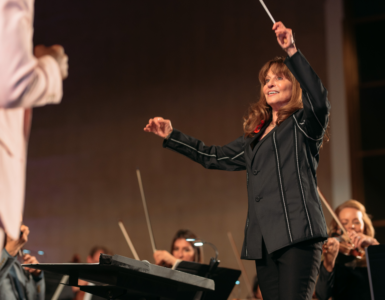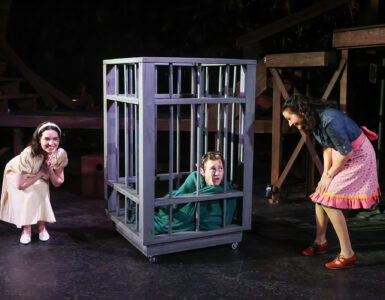
***
Theatre, drama, comedy, tragedy – all these forms of expression and entertainment originated in Ancient Greece. But being an ephemeral art form, few play texts, accounts or manuscripts have survived the centuries.
The Art of Ancient Greek Theater, on view at the Getty Villa until January 3rd, 2011, is the first exhibition in the United States in over fifty years to focus on the artistic representation of theatrical performance in ancient Greece.
This is a fascinating and comprehensive exhibition that is a must-see for enthusiasts of theatre and ancient artifacts. Expertly curated by the astoundingly knowledgeable Mary Louise Hart, the Getty”™s curator of antiquities, and assembled over several years, this exhaustive exhibition is on display within three of the second storey galleries at the Getty Villa.
Visitors will gain a thorough, vividly illustrated history of performing arts in the Greek empire, from the sixth century B.C. into the early Roman era. Most of the accompanying information is obtained from the wall texts, which undertake the difficult task of explaining a complex and disputed history as succinctly as possible.
I strenuously urge anyone visiting this exhibition to obtain an audio tour, otherwise you may find yourself overwhelmed by the singular appearance of the vases which all start to look fairly similar after a while!
Nevertheless, this is an impressive assemblage of artifacts. Curator Mary Louise Hart has tracked down””from 22 museums in 11 countries”” various antiquities revealing images of ancient Greek performers both onstage and off, most of them from vivid illustrations on almost fifty elegant vases and vase fragments, as well as small figurines and other pieces.

A highlight of the exhibition is The Gela Krater, a monumental red-figure volute-krater (wine mixing vessel). Produced in Athens between 475 and 450 B.C., this large piece  was excavated in 1889 at the site of Gela, formerly an ancient Greek colony founded on the southeastern coast of Sicily. A luxurious banquet vessel used to mix and serve wine, the krater stands almost 80 cm (31.5 inches) high. Decorated in the red figure technique, its body is illustrated with a vivid battle between armored Greek warriors and their mythical female opponents, the Amazons, a combat known as an Amazonomachy.
HISTORY:
The word for theatre derives from the Ancient Greek theatron meaning, “place for seeing.” The first recorded theatrical event was a performance of the sacred plays of the myth of Osiris and Isis in 2500 BC in Egypt. Performed annually at festivals throughout the civilization, this marked the beginning of a long relationship between theatre and religion.
The ancient Greeks began formalizing theatre as an art, developing strict definitions of tragedy and comedy as well as other forms, including satyr plays. Like the religious plays of ancient Egypt, Greek plays made use of mythological characters. The Greeks also developed the concepts of dramatic criticism, acting as a career and theatre architecture.
Early theatre”™s relationship with religion started with male drinking parties in honor of the god Dionysus, which evolved into wine and music-fuelled dance and choral spectacles staged by men and boys, as depicted in vivid vase paintings. Dionysus is typically accompanied in these paintings by an entourage of sexy female Maenads and even sexier male Satyrs, nude and erect. Actors playing satyrs wore tight shorts decorated with long tails and erections. Later, comic actors playing old buffoons were often equally well-endowed, if flaccid, with padded bellies and behinds.
Assembling international loans of antiquities from many museums and private collections, the exhibition illustrates the ways in which dramatic performance was depicted in the visual arts of ancient Greece between the fifth and the first centuries B.C. The exhibition is being presented in conjunction with the Getty Villa”™s annual outdoor theater performance, Sophocles”™ Elektra.
“Ancient art and theater share a strong and enduring connection-one that is inspired by mythology and the social, cultural, and political realities of life in ancient Greece and Rome,” says David Bomford, acting director of the J. Paul Getty Museum. “With this exhibition and our annual production in the outdoor theater, we are delighted to bring ancient theater alive at the Getty Villa and invite our visitors to join us and discover how those themes found in ancient times persist today.”
The Art of Ancient Greek Theater spans centuries of artistic production throughout the cities of the Mediterranean. The exhibition showcases magnificent Athenian and South Italian vases as well as significant marble reliefs and numerous terracotta masks and figurines drawn from major collections in Denmark, Australia, New Zealand, France, Germany, Italy, Spain, The Netherlands, Switzerland, the United Kingdom and the United States.

Themes of the Exhibition:
Elaborate costumes, complex choreography, scenic architecture, and the mask””which continues to be an icon for tragedy and comedy””are vividly depicted in the visual arts of ancient Greece.
An introductory section introduces visitors to the architectural and physical environment of ancient Greek theater. A large mural map, locating about one hundred ancient theaters in the Mediterranean, reinforces the importance of drama to the civic and religious life in the ancient Greek world. Complementing the map are marble sculptures of actors and poets as well as a model of the Theater of Dionysos in Athens, the home of the festival of the Great Dionysia, where the plays of Aeschylus, Sophocles, Euripides and Aristophanes were originally performed.
The exhibition is organized in three general themes. The first theme is devoted to the historical context of ancient Greek performance. Springing from the worship of Dionysos, theatrical performance developed out of the god”™s religious rites and festivals. Objects on view depict actors, costumes, masks, choruses and chorusmen, with Dionysos the god of theater as motivator and benefactor.
The second theme focuses on tragedy and the satyr plays and will present comparative installations of vase-paintings inspired by ancient performances of Athens”™ renowned tragedies: Aeschylus”™ Oresteia; Euripides”™ Medea, Herakles, Children of Herakles, Andromache and Iphigenia in Aulis; and Sophocles”™ Oedipus. Objects representing satyr play will be anchored by the exceptional loan of the great Pronomos Vase from the Museo Archeologico Nazionale in Naples.
The third theme of the exhibition features comedy. Depictions of comic parodies and farces, where gods and centaurs share the stage with plotting slaves and thieves, and genre vase-painting represents costumed and masked actors in scenes on ancient stages, include some of the most vivid painting from the ancient world.
“We hope that our visitors will come away with a rich understanding not only of the context of ancient Greek theatrical performance but of the many ways artists interpreted the choruses and plays they witnessed. These vase-paintings, reliefs and figurines are often the only evidence we have for many aspects of ancient drama. Significantly, the heightened visual style and attention to details such as costumes and choreography result in portrayals of ancient actors, poets, and musicians that give us an immediate sense of their performance on stage,” says Mary Louise Hart, associate curator of Antiquities at the J. Paul Getty Museum, who curated the exhibition.
Performance:
During the run of The Art of Ancient Greek Theater, the Getty Museum will present Sophocles”™ Elektra directed by Carey Perloff, artistic director of the American Conservatory Theater in San Francisco, with a new translation commissioned from Timberlake Wertenbaker. Elektra will be performed in the Barbara and Lawrence Fleischman Theater at the Getty Villa on Thursday, Friday, and Saturday evenings, until October 2, 2010.
In addition, the Villa Theater Lab will present Understanding a Satyr Play: The Trackers on November 19th and 20th, 2010.
The J. Paul Getty Trust is an international cultural and philanthropic institution devoted to the visual arts that features the J. Paul Getty Museum, the Getty Research Institute, the Getty Conservation Institute, and the Getty Foundation. The J. Paul Getty Trust and Getty programs serve a varied audience from two locations: the Getty Center in Los Angeles and the Getty Villa in Malibu.
Visiting the Getty Villa:
The Getty Villa is open Wednesday through Monday, 10 a.m. to 5 p.m. It is closed Tuesday and major holidays. Admission to the Getty Villa is always free. A ticket is required for admission. Tickets can be ordered in advance, or on the day of your visit, at www.getty.edu/visit or at (310) 440-7300. Parking is $15 per car, but free after 5pm for evening events. Groups of 15 or more must make reservations by phone. For more information, call 310-440-7300 (English or Spanish); 310-440-7305 (TTY line for the deaf or hearing impaired). The Getty Villa is at 17985 Pacific Coast Highway, Pacific Palisades, California.
Additional information is available at www.getty.edu.
Sign up for e-Getty at www.getty.edu/subscribe to receive free monthly highlights of events at the Getty Center and the Getty Villa via e-mail, or visit www.getty.edu for a complete calendar of public program.
Review by Pauline Adamek








After shaking hands with a Greek, count your blessings.
Uau! Obrigado! Eu sempre quis escrever alguma coisa no meu site como esse. Posso tomar parte do seu post no meu blog?
CFrequently I can’t understand report in blogs and forums, however wish to declare that that write-up very compelled myself to look at in addition to do so! Your way of writing has become astonished everyone. Cheers, pretty wonderful write-up.